On a sunny summer day in Montauk, in New York State, Ipek Irgit was in the familiar situation of not knowing what she was doing with her life. It was 2012, and she was 34 years old. Earlier in the year, after having her heart broken, she had taken a vacation in Brazil, visiting Rio de Janeiro and the beach towns of Bahia. Now she was on the beach on Long Island, wearing a handmade-looking bikini with crochet and exposed elastic straps, trying to figure out what to do and who to be.
It had been 11 unsettled years since Irgit moved from Turkey to New York, with $300 (about €260) in her pocket and a vague dream of making a life in one of the city’s creative industries. She became part of a downtown class of trendsetters who all seemed to have a purpose. It was an expensive existence, especially for Irgit, who, without the cushion of a trust fund, bounced from job to job. She was a waitress and a bartender; she worked for a fashion company as an assistant to a merchandiser and in the wholesale department. Nothing stuck.
On the Montauk sand, Irgit was playing paddle ball with a friend, restaurateur Serge Becker, when he complimented her striking bikini. As Irgit would later put it, this was the spark that motivated her to start a business. Why not create more of these distinctive bathing suits? Why not become a bikini-maker?

Irgit looked at the bathing suit and saw untapped “superpowers”. It was bright, colourful and looked fantastic on Instagram. Its tiny form contained an unexpected array of elements: triangular panels; contrast-colour stitching; and most distinctively of all, those vibrant elastic straps threaded through loops of crochet. The suit had a DIY sensibility popular on both the internet and the runway, and Irgit hoped buyers would see it as sexy but sporty, bohemian but sophisticated. “A reflection”, she said, “of my personality”.
Irgit asked a friend in the fashion industry to create a prototype, and a factory in China made a batch at a cost of about $29 (about €25) each. Irgit decided to mark up the retail price to $285 (about €249), putting her suit into the high-end luxury market. She paid careful attention to branding, playing around with “bikini” and her initials – I.I.I. – before settling on “Kiini” and a logo with three triangles over the “I”s, like the panels on the top and bottom of her suits.
In June 2013, Kiini had its launch party at a buzzy restaurant owned by Becker. Models, stylists and other denizens of the beautiful-people set sipped Caribbean beer and posed for photos with Irgit, who wore bright lipstick and a pilot-style jumpsuit unbuttoned nearly to the navel, revealing her Kiini top beneath.
As is often the case in fashion, Kiini's success drew copycats. Irgit complained about it to her lawyer
Sales were unremarkable until January, when Irgit’s product got its first significant Instagram plug. The model Dree Hemingway posed provocatively by a surfboard in a bikini with dark panels and green-and-orange detailing. She captioned: “Thank you for my Kiini!!”
“I was, like, bombarded”, Irgit said. “That was it”.
Sales were exploding. By 2015, Irgit's suit had brought in approximately $9 million, said Sally Wu, who for years helped the company source its bikinis from China.
As is often the case in fashion, Kiini’s success drew copycats. Irgit complained about it to her lawyer, who advised her to apply with the US Copyright Office for protection.
Irgit came to regard knockoff makers with rage. She seethed when confronted by Instagram images erroneously referring to impostor Kiinis as the real article, and even hired a company to scrub such posts of the #kiini hashtag. Irgit told a lifestyle website that “one of my big challenges has been trying to keep up with demand without losing integrity and hiring the right people to help without panicking. My biggest challenge right now is the copiers around the world. People say I should be flattered but I despise all of them. It just shows a very ugly face of humanity to me.”
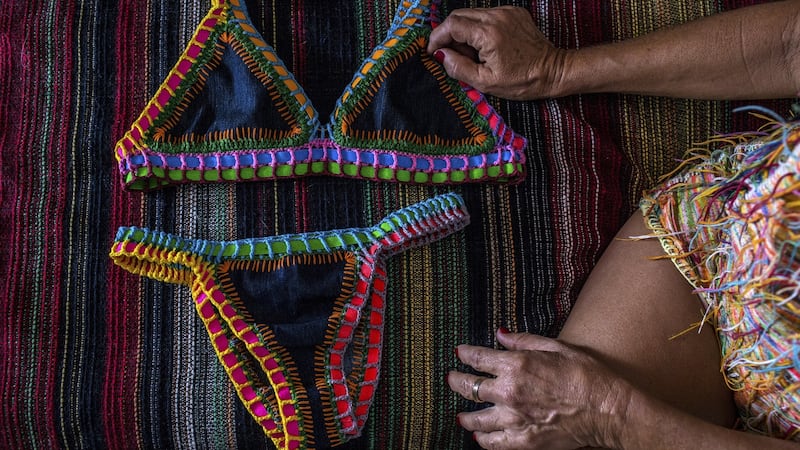
The tiniest two-piece can hide a lot of secrets
In fashion, there is a fine, sometimes indistinguishable line separating inspiration and theft. Most apparel companies try not to get distracted by items that are derivative of their own. The trend cycle moves so quickly that experts tend to believe the best use of resources isn’t litigation but creating next season’s styles.
Irgit, though, could not abide the idea of rival versions of colourful crocheted bikinis. In 2015, she was particularly inflamed by the introduction of a faux-Kiini made by Victoria’s Secret. That October, in the central district of California, her lawyers filed a federal lawsuit accusing the company of copyright infringement. It called for Victoria’s Secret to stop selling the swimwear and pay damages.
The lawsuit was a mismatch – teeny Kiini versus vast Victoria – but Irgit was scrappy. At one point, she surreptitiously recorded a meeting with a former Victoria’s Secret swimwear designer. Then Kiini’s lawyers deposed the designer; when her testimony contradicted what was on the secret tape, they played it back for her, making for a dramatic and embarrassing moment. As the litigation dragged on, Victoria’s Secret decided to get out of the swimwear business altogether, and by March 2017 the company and Kiini had agreed to a confidential settlement. (Victoria’s Secret declined to comment.)
For an upstart brand, one lawsuit was rare. A second was unheard of
Irgit felt victorious. A year later, in April 2018, Kiini filed another federal lawsuit, this time in the southern district of New York, against Neiman Marcus and two swimwear companies. It accused them of unfair competition, misleading consumers about the origin of the swimsuits and violating Kiini’s “trade dress.” In lay terms, Kiini was saying that any consumer in the world who saw a crocheted-and-exposed-elastic bikini would assume it was a Kiini.
For an upstart brand, one lawsuit was rare. A second was unheard of. Kiini’s litigiousness brought Irgit unwanted attention – and revealed that even the tiniest two-piece can hide a lot of secrets.
One day in August, Irgit greeted me at a loft in the Tribeca neighborhood of New York City, a large and airy space that serves both as her home and as Kiini’s showroom and office. We sat at a long, rectangular kitchen table that separates the living area and the workspace. It is a point of pride for Irgit that she used her own marketing savvy to develop Kiini’s high profile without the use of a publicist, but our interview took place under specific conditions negotiated by Risa Heller, a crisis communications consultant.
As we spoke, Irgit shared her disdain for the legal process – a hatred of lawsuits and a belief that it is lawyers who benefit the most from them. It was the creative process she most cherished, she said. She meandered, though, when I asked her repeatedly to talk about inventing the Kiini. Did she sketch it? How did she come up with the idea of threading elastic through crochet?
Ferrarini has been selling handmade crochet-and-elastic bikinis on the beach since 1998. 'I created this bikini to survive'
“It goes back to with my grandmother,” Irgit said, in her most specific answer. “We used to make things like crochet bikinis, so I was like 10 and 11.”
“You made crochet bikinis when you were 10?” I asked.
“Not me, I’m not making them, right?” Irgit said. “No, ‘make’ is like – it is usually my idea. I’m not that – I didn’t make them. My mom made it, or my grandma made it.”
What about the bathing suit Irgit was wearing on the beach in Montauk in 2012 with Becker? Who made it? “I had had it made,” was all Irgit would say.
I called Becker, her paddle-ball partner.
He remembered the moment well. “She was wearing it,” Becker said. “I noticed it and I said it was really cool. She told me she had found them in Brazil and was contemplating starting to do something with it in different varieties.”
Maria Solange Ferrarini lives in Trancoso, a beach town in Brazil's Bahia state, along a dirt road littered with garbage and stray animals. When I walked up to her tidy four-room home one day this summer, she greeted me dressed in crocheted shorts with brightly coloured elastics woven through them. Under a sleeveless T-shirt, she wore a similar bikini top.
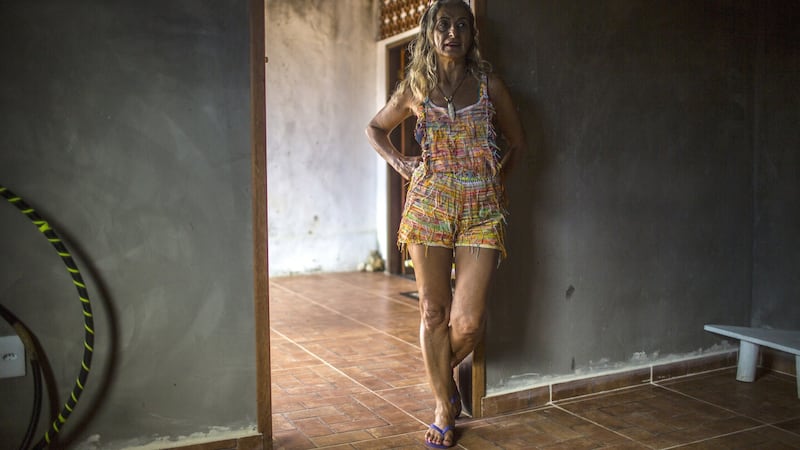
Inside, as we talked with the help of a translator, Ferrarini picked up a ball of yarn stuck through with a needle. She had a habit of grabbing it and crocheting absent-mindedly, holding it almost like a rosary, as she told her story.
Ferrarini, who is 61, described herself as a street artist, but most people in Trancoso know her as the bikini lady. Since 1998, she has been selling handmade crochet-and-elastic bikinis on the beach, walking up and down the sand with her creations dangling off a hula hoop. She and the suit are inseparable. “It’s my husband,” she said, with a laugh.
I looked at one of the bikinis in her living room. Ferrarini’s standard two-piece has two dark denim triangles connected by visible stitches of embroidery thread to crochet straps with brightly coloured elastics woven through them. The bottom is made to match. It is virtually identical to the bikini Irgit had copyrighted.
“I created this bikini to survive,” Ferrarini said. She was born in São Carlos, a university city outside São Paulo, where her father was a bricklayer and her mother was a seamstress. When she was 10, her mother taught her to crochet so that she could make clothes for herself and her younger sisters. Around 1994, she moved to Trancoso, took a room in a guesthouse and tried to make money with her craft. She crocheted thong bikini bottoms and sold them by pacing the beach. It was nudist, though, and that created a problem.
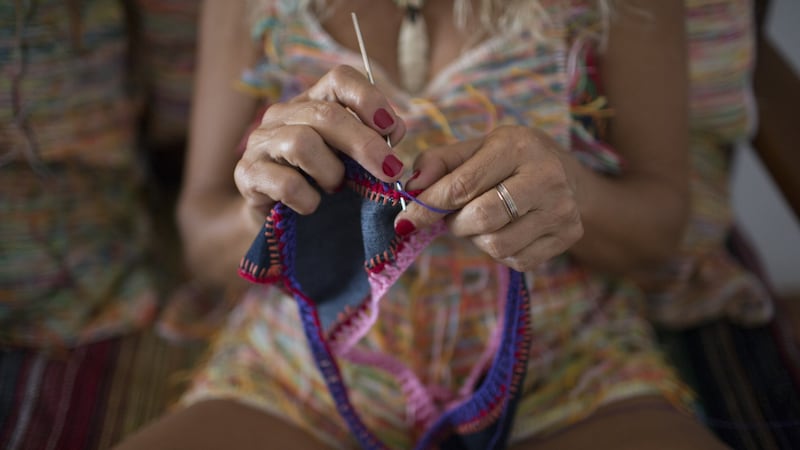
To get back to the guesthouse at the end of the day, Ferrarini had to pass a seaside church. As a Catholic, she didn’t feel right walking by in just a thong, with her breasts exposed. In reverence, she added a handmade, curtain-like top that draped over her chest. The design evolved into a bikini top.
When Ferrarini realized she needed more support than yarn could provide, she began to thread elastics through the crochet to give a little lift. Other women quickly took note. They asked her to make tops for them, too. Initially, she sold the bikinis for the equivalent of $2.50 (around €2.20). She increased the price by about $5 (€4.40) every couple of years.
The Trancoso tourist economy was gaining steam by 2009. That year, Vogue called it "Brazil's hottest beach town," reporting that it was a favorite of no less an authority on sandy outposts than the Brazilian supergoddess Gisele Bündchen. It was the sort of beach that famous people and other fashionable types sought out. In the winter of 2012, The Daily Mail published photos of British celebrity Kelly Brook on the beach in Trancoso, wearing one of Ferrarini's bikinis.
It was around that time that the town was visited by another trendsetter: Ipek Irgit. She confirmed the visit during our interview.
Before I left Trancoso, I accompanied Ferrarini on a sales walk along the beach. She arranged a sale to a woman from California and then sold a top to another tourist, from Canada, who mentioned she’d seen the same style “all over the place.”
Ferrarini sighed. She was used to that, she said, but it still stung. To her, an artist, it is about creative integrity. “I’d see people in bikinis, and foreigners doubted that I was the creator,” she said. “They said the bikini was from the United States. To my face!”
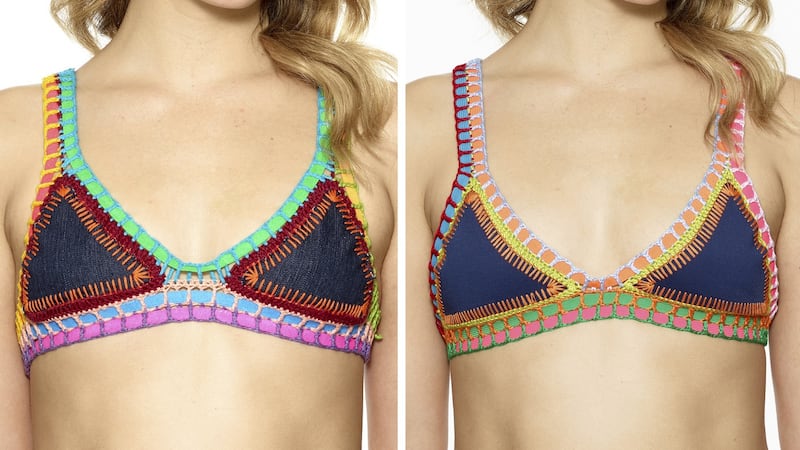
“Listen, Ipek, I’m not going to lie”
Sally Wu was happy on the day in mid-2012 when her friend, Irgit, contacted her to ask a favor. Earlier in the year she had been traveling in Brazil, she said, and was home with a new bikini. Wu said that Irgit told her, “I need to figure out how to copy it.”
Wu was a good person to ask. Raised in Shanghai, she had moved to New York and become a fashion designer, then segued into the industry’s “private label” niche, working as a product developer and bilingual liaison between brands and Chinese manufacturers. She understood design, production and importing.
In Wu’s recollection, Irgit brought a bikini to her Chinatown apartment and laid it on a couch. Wu saw that the suit, particularly the top, would be more complex to reconstruct than a layman might imagine. It would be tricky for yarn, for instance, to maintain its structure and colour while being regularly submerged in water. And the unlined fabric would need to be a certain thickness, or else it would be see-through. She walked Irgit through each step of the replication process.
“She is not a designer”, Wu said of Irgit this summer, as we sat on the back terrace of her current home, in East Harlem. “But she is a good marketer. She knows how to create a brand, and she really knows how to market a product.”
After their initial consultation, Wu asked Irgit to send her a document of specs that Wu could relay to a Chinese manufacturer. Irgit sent the email on July 28th, 2012. “Sally darling”, it began, and referred Wu to attached photos, with measurements and colours annotated. Irgit signed it “xo i”.
Working with the factory, Wu helped to create a prototype. Irgit loved it and asked for 300 more. Wu was worried about such a large order; if they didn’t sell, Irgit would be out a lot of money. But the Kiinis did sell – and sell and sell. What started as a favor for Irgit became a major time commitment. “Even in winter, we were shipping to Australia, shipping to Europe, shipping to New York,” Wu said. Irgit was crazed trying to manage the commercial demand and the press attention.
The two women were consumed by work, and their relationship was fraying. Wu urged Irgit to expand her brand beyond a single motif. She made suggestions that Irgit ridiculed. Given the frostiness, Wu was surprised, she said, to get a phone call from Irgit one night in the late summer of 2016.
“Can I come over?” Irgit asked.
About a half-hour later, she arrived. She was nearly a year into litigation with Victoria’s Secret, and she explained that in the discovery process, lawyers for Victoria’s Secret had learned that Wu had had a hand in Kiini’s production. Victoria’s Secret had given Irgit’s lawyers advance notice that Wu was going to receive a subpoena for a deposition.
Wu said she clearly recalled what Irgit said next. “She’s like, ‘You can’t really tell them I copied.’ I said, ‘Listen, Ipek, I’m not going to lie.’” (Irgit disputed Wu’s recollection. “It’s a lie,” she said.)
The two women talked some more. Wu was upset about getting pulled into a legal mess. Irgit was worried about how the drama could impact Kiini’s production.
Before Irgit departed, Wu said, Irgit wrote a note on a yellow sticky pad. It read, “If Kiini LLC wins the VS case Ipek is treating” — the penmanship is imprecise and the word “treating” might be “hosting” or “having” — “Sally ChaCha and 3 optional friends on holiday anywhere in the world!” (Cha Cha was a nickname for Wu’s daughter.) She signed it “Ipek,” underlining her name in a flourish.
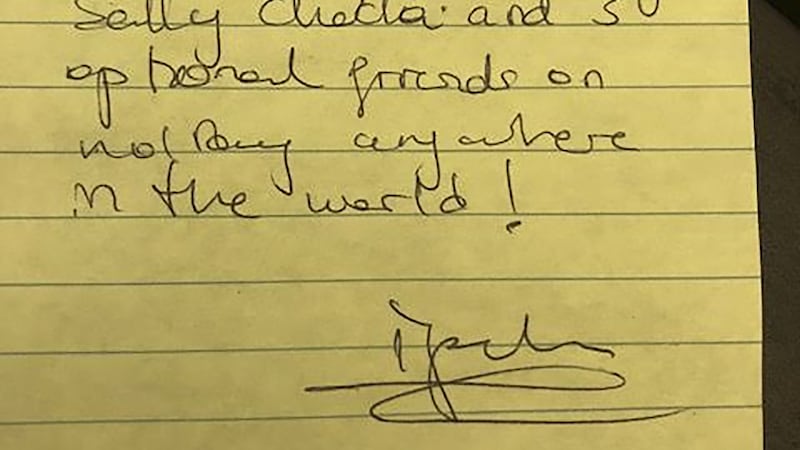
Wu said she never received a subpoena. The next year, Victoria’s Secret settled the lawsuit with Kiini.
By April 2018, around the time that Kiini sued Neiman Marcus, Wu and Irgit’s friendship and business arrangement had totally deteriorated. They had a blistering fight over email, with each woman impugning the other’s integrity, and Wu stopped working with Kiini.
Not long after, Wu had dinner with a friend, an entrepreneur named Doug Schmidt. She told him the whole story about her work with Irgit: replicating that first Brazilian bikini, the copyright, the lawsuits. Schmidt told Wu that he had friends at Neiman Marcus. He bet they'd want to hear her story, too.
The lawyer zoomed in
Jason Forge was for years a federal prosecutor in US attorney's offices in California, going after dirty politicians and corrupt CIA officials. Now he is in private practice; in his most notable case, he represented students in a class action against Trump University, winning them $25 million (about €218 million). Also, Forge is married to an owner of a swimwear supplier called PilyQ, which makes a crochet suit that looks a lot like a Kiini. Under a brand called Platinum, PilyQ has for some time been selling that suit to Neiman Marcus.
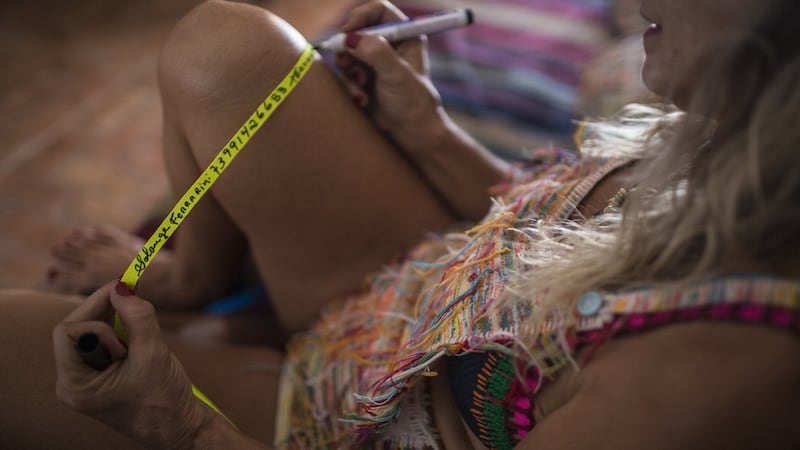
In April, lawyers for Kiini sent Neiman Marcus a letter urging it to cease and desist selling swimwear from brands including Platinum. Neiman Marcus notified PilyQ, Platinum’s parent, and Forge started digging on PilyQ’s behalf. He got in touch with lawyers involved in the Victoria’s Secret litigation and heard rumors of an unacknowledged bikini maker in Brazil.
Online, he found a video made by a friend of Ferrarini’s in 2016 that displayed her phone number. Forge reached Ferrarini, who consulted a lawyer, and quickly negotiated a nonexclusive deal. In May, in exchange for using her crochet-and-elastic design and her name, PilyQ paid Ferrarini the equivalent of about $5,100. (In January 2019, she’ll get an annual fee of about $7,700, about €6,700). Neiman Marcus and other major retailers now sell a suit under the name “Platinum Inspired by Solange Ferrarini” for about $170 (about €150).
This summer, Forge was thrilled to learn from someone at Neiman Marcus that there was a woman named Sally Wu who had worked with Irgit from the beginning. Forge met Wu for a drink and got her story. She subsequently emailed him a photo of the yellow sticky note with Irgit’s signed offer. She also agreed to give Forge access to data from her old hard drives.
Within days, he was looking at the “Sally darling” email Irgit sent to Wu some six years earlier, with photographs of the bikini she wished the Chinese producers to use as a reference for her prototype. On his computer, Forge scrutinized the pictures for details. One image was of the bikini bottom turned inside out.
Forge zoomed in. He zoomed again. Then he saw it. “I could not believe my eyes,” Forge told me. On the elastic, in marker, was a phone number, the words “Trancoso, BA” and the signature of Solange Ferrarini.
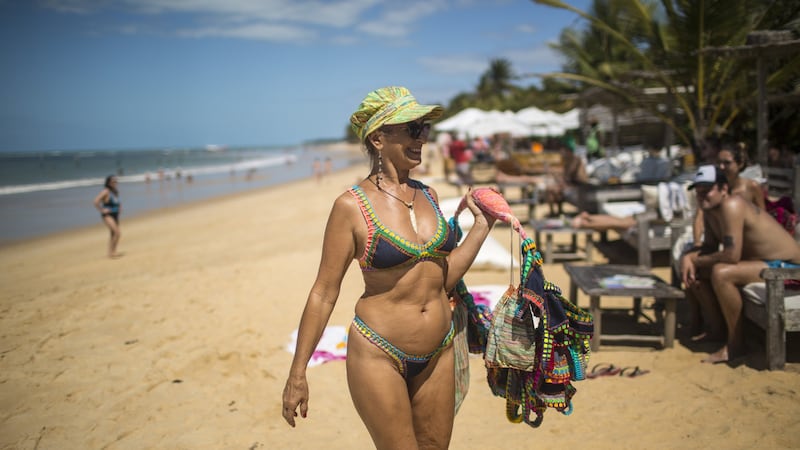
“If true, it’s breathtaking”
In May 2018, as Forge was conducting his work, Kiini amended its lawsuit against Neiman Marcus to formally add PilyQ, Bloomingdales, Lord & Taylor, Macy’s and others as defendants. Forge found it outrageous. The way he saw it, PilyQ was compensating Ferrarini for her creation – and was now being sued by someone who he believed had copied that work and passed it off as her own to the US Copyright Office.
"The role of truth in our judicial system is central," said Jeanne Heffernan, a partner in the law firm Kirkland & Ellis. "Here you have a woman who appears to have taken the IP [intellectual property] of someone else and registered it as her own – and then, it seems, had the audacity to sue an industry over something she did not create and may have stolen. If true, it's breathtaking. I would think Victoria's Secret would want to take a second look at their settlement."
When I spoke to Irgit in her Tribeca apartment this summer, she said she was not concerned about the case and was trying to focus on her company. Sales are not what they were during what Wu said were the peak times of 2015 and 2016, but Irgit is developing new products, including swimsuits for girls.
As for the allegations in the lawsuit, Irgit said she sent photographs of Ferrarini’s bikini to Wu in 2012 because she liked the colours.
At one point during the interview, Irgit walked into another room and returned with what she considered evidence that she created the design that became the Kiini. It was a bikini made in the Ferrarini/Kiini style, with elastic woven through crochet sewed to fabric – in this case, padded leotard-like pink fabric with mustard-yellow polka dots. The suit, she said, was made in 1999 and had been at her aunt’s house in Turkey until recently.
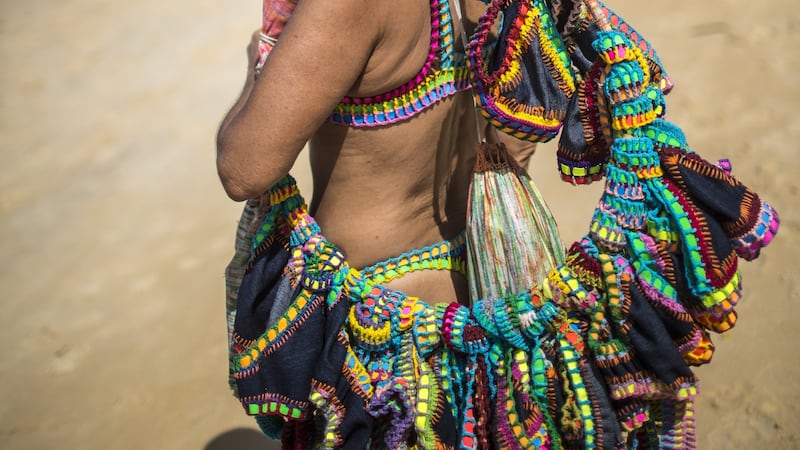
Irgit declined to be quoted directly on a number of topics.
Last month, though, she sent me an email expressing anger at Wu. She was even angrier with PilyQ and Forge, whom she called a “bully” and a “scumbag.”
Back in Trancoso, I asked Ferrarini what she wished would happen to Irgit. She replied with a reference to the colours of Brazil, and maybe of the bikini she had crocheted into existence. “Eu quero que ela se ferre em verde e amarelo,” she told me. “I want her to get screwed in green and yellow.” – New York Times





















